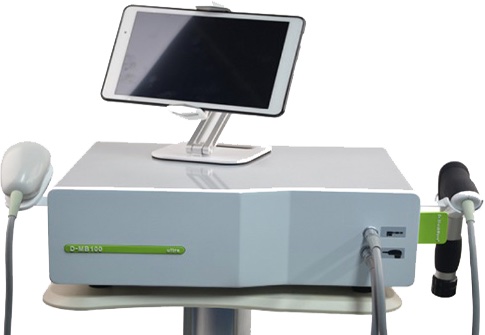Shockwave Therapy
Our practice specializes in providing modern and non-invasive treatment options for orthopedic pain.
Extracorporeal shockwave therapy (ESWT) has proven to be a safe and effective treatment method in orthopedics and sports medicine. In fact, universities and Olympic team doctors are among those who include ESWT in their spectrum of services.
What is Extracorporeal Shockwave Therapy?
Extracorporeal Shockwave Therapy is a series of high-energy percussions to the affected area. The shockwave is a physical acoustic/sound wave "shock", not an electric one.
How does it Work?
Treatment produces an inflammatory response. The body responds by increasing metabolic activity around the site of pain. This stimulates and accelerates the healing process (promotes the remodeling of dysfunctional collagenous tissues, such as tendinopathies, trigger points, muscle strains, etc.).
Shockwaves break down scar tissue, adhesions and/or calcifications.
Transmission of pain is diminished through neurological mechanisms (inhibition of nociceptors).
What are the Benefits of Shockwave Treatment?
This therapy stimulates the body's natural self-healing process. There is an immediate reduction of pain and an improved range of motion.
How long does the treatment last?
The treatment duration is approximately three to five minutes. Some patients and/or conditions require more shocks and a longer duration, depending on severity and chronicity (how long the condition or injury has existed).
Treatment Costs
The cost of a single treatment is $65.
How many Treatments will I Need?
Typically, five to seven treatments per area are necessary at weekly intervals; there is a small possibility that additional treatments may be necessary if your condition is very chronic. Should you not respond in this time, your case will be reviewed with the doctor to determine the appropriate next steps. Success rates with ESWT are unparalleled (over 80-90% improvement).
Does the Treatment Hurt?
There can be some discomfort during the treatment, but you should not feel severe pain. Most are able to easily tolerate this discomfort; however, adjustments on the machine can be made to decrease any pressure you may feel.
Will it Hurt after the Treatment?
There may or may not be immediate pain or discomfort, there may or may not be some discomfort two to four (2-4) hours after the treatment. In some cases, the discomfort can last up to forty-eight (48) hours, and in very rare cases, the discomfort might last for several days. Some bruising and swelling might occur.
What Should I do if I am in Pain After the Treatment?
The shockwave will trigger an inflammatory response, which is the body's natural process of healing. For this reason, do not use anti-inflammatory supplements or medications. Do not use ice. The pain should subside within the first twenty-four (24) hours. Use Tylenol if absolutely necessary, provided you have no trouble with this medication.
What if it Feels Good After the Treatment?
Even if it feels good, we recommend decreased activity for forty-eight (48) hours following the treatment.
Is Shockwave Therapy Covered by My Insurance?
Unfortunately, shockwave therapy is currently not covered by your health insurance.
What is the success rate of this kind of treatment?
Successful treatment is considered as a patient having at least 70% reduction in pain within three months. Worldwide, success rates are around 80% to 90%.
What if it Doesn't Work for Me?
Although the short-term effects alone are exceptional, the long-term benefits of this treatment may take up to three or four months. If after this time there has not been any marked improvement, you should see your doctor for further treatment options.
Are there contraindications and/or precautions? Contraindications include:
- Pregnancy
- Children in growth
- If you have a pacemaker
- Coagulation disorders, thrombosis, heart or circulatory patients
- Use of anticoagulants, especially Marcumar, Heparin, Coumadin
- Tumor diseases, carcinoma, cancer patients
- Polyneuropathy in case of diabetes mellitus
- Acute inflammations / pus focus in the target area
- Cortisone/steroid therapy up to six weeks before first treatment
- Treatment over an air-filled area such as the lungs or guts is not possible
Side effects include: (These side effects generally abate after 5 to 10 days.)
- Aches or Pain
- Petechiae, bruising
- Swelling, reddening, hematomas
- Skin lesions (especially after previous cortisone therapy)

